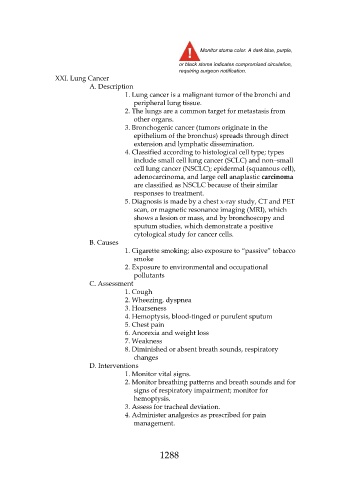Page 1288 - Saunders Comprehensive Review For NCLEX-RN
P. 1288
Monitor stoma color. A dark blue, purple,
or black stoma indicates compromised circulation,
requiring surgeon notification.
XXI. Lung Cancer
A. Description
1. Lung cancer is a malignant tumor of the bronchi and
peripheral lung tissue.
2. The lungs are a common target for metastasis from
other organs.
3. Bronchogenic cancer (tumors originate in the
epithelium of the bronchus) spreads through direct
extension and lymphatic dissemination.
4. Classified according to histological cell type; types
include small cell lung cancer (SCLC) and non–small
cell lung cancer (NSCLC); epidermal (squamous cell),
adenocarcinoma, and large cell anaplastic carcinoma
are classified as NSCLC because of their similar
responses to treatment.
5. Diagnosis is made by a chest x-ray study, CT and PET
scan, or magnetic resonance imaging (MRI), which
shows a lesion or mass, and by bronchoscopy and
sputum studies, which demonstrate a positive
cytological study for cancer cells.
B. Causes
1. Cigarette smoking; also exposure to “passive” tobacco
smoke
2. Exposure to environmental and occupational
pollutants
C. Assessment
1. Cough
2. Wheezing, dyspnea
3. Hoarseness
4. Hemoptysis, blood-tinged or purulent sputum
5. Chest pain
6. Anorexia and weight loss
7. Weakness
8. Diminished or absent breath sounds, respiratory
changes
D. Interventions
1. Monitor vital signs.
2. Monitor breathing patterns and breath sounds and for
signs of respiratory impairment; monitor for
hemoptysis.
3. Assess for tracheal deviation.
4. Administer analgesics as prescribed for pain
management.
1288

